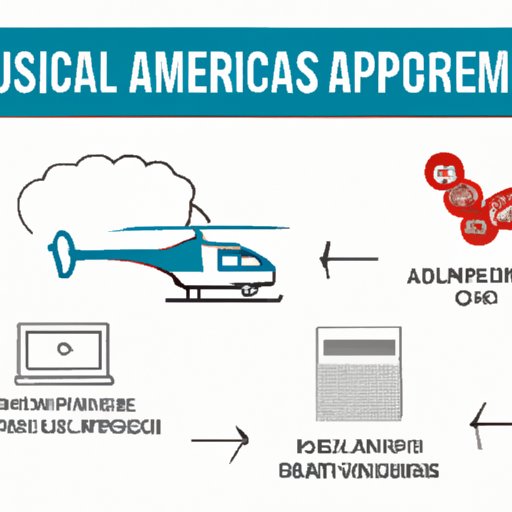How Much Does Medicare Pay for Air Ambulance Services?
When it comes to emergency medical care, every second counts. For those who need air ambulance services, the cost can be a major concern. However, Medicare provides coverage for air ambulance services under certain circumstances. Understanding Medicare’s coverage and payment policies for air ambulance services can help patients and their families navigate this complex issue and avoid unexpected costs.
An Explainer: Understanding How Medicare Covers Air Ambulance Services
Air ambulance services refer to the transportation of patients by helicopter or airplane in emergency situations. Air ambulance services are crucial in providing timely medical care to patients who are in remote areas or who require transport to a specialized medical facility.
Under Medicare Part B, air ambulance services are covered when they are considered medically necessary. Medicare defines medical necessity as a service or item that is reasonable and necessary for the diagnosis or treatment of a medical condition or illness. For air ambulance services to be considered medically necessary, they must meet certain criteria, including:
- The patient’s condition requires immediate and rapid transport that cannot be provided by ground ambulance
- The patient’s condition requires continuous medical supervision and treatment during transport
- The transport is from one medical facility to another that is equipped to provide the necessary medical treatment or services
Medicare also covers air ambulance services under Medicare Advantage (Part C) plans, which are offered by private insurance companies that contract with Medicare to provide Medicare benefits. The coverage and criteria for air ambulance services under Medicare Advantage plans vary depending on the plan.
It’s important to note that Medicare only covers the cost of air ambulance services to the “nearest appropriate facility” that is capable of providing the necessary medical care. This means that the closest medical facility may not necessarily be the one that the patient wanted to go to or the one that is most convenient for them. If the patient chooses to be transported to a different facility, they will be responsible for any additional costs.
It’s also important to note that Medicare only covers medically necessary air ambulance services. If the air ambulance transport is not considered medically necessary, such as for non-emergency situations or for transport to a non-medical facility, then the cost will not be covered by Medicare.
The Cost of Life: Navigating Medicare Coverage for Air Ambulance Services
The cost of air ambulance services can vary widely depending on factors such as the distance traveled, type of aircraft used, and any additional medical equipment needed. According to a 2020 report by the Government Accountability Office, the median price for an air ambulance trip in 2017 was about $36,400.
For patients who need air ambulance services, the cost can be a significant financial burden. Even with Medicare coverage, patients may still be responsible for out-of-pocket expenses, such as deductibles, coinsurance, and copayments. These costs can add up quickly, especially for those with limited incomes or who are on a fixed budget.
Given the potential financial impact of air ambulance services, it’s important for patients to understand the cost implications and the coverage provided by Medicare.
The Ins and Outs of Medicare Coverage for Air Ambulance Services
To obtain Medicare coverage for air ambulance services, the treating physician or healthcare provider must certify that the patient’s condition meets the medical necessity criteria. The air ambulance provider must also submit documentation to Medicare showing that the transport was medically necessary and met the “nearest appropriate facility” rule.
It’s important to note that Medicare’s documentation requirements for air ambulance services are strict and can affect the payment decision. If the required documentation is not submitted or does not meet Medicare’s requirements, the claim may be denied, and the patient may be responsible for the full cost of the transport.
If a claim is denied, patients have the right to appeal the decision. Common reasons for denial include a determination that the transport was not medically necessary or that the documentation was incomplete or incorrect. Medicare provides guidance and resources for patients who want to appeal a denied claim.
Beneath the Surface: A Closer Look at How Medicare Pays for Air Ambulance Services
Medicare pays for air ambulance services on a fee-for-service basis under Part B. Air ambulance providers are required to accept the Medicare-approved amount as payment in full. However, if the air ambulance provider is not enrolled in Medicare or does not accept Medicare assignment, they may charge the patient up to 15% more than the Medicare-approved amount. This is known as balance billing, and patients are responsible for paying for any amounts not covered by Medicare.
Additionally, Medicare uses a “reasonable charge” methodology to determine the payment amount for air ambulance services. Under this method, Medicare pays the lesser of the actual charge for the service or the “reasonable charge” as determined by Medicare. The reasonable charge is the amount that Medicare determines to be appropriate for a particular service based on the cost of providing the service in the local geographic area. Air ambulance providers who do not accept the Medicare-approved amount may charge patients the difference between the reasonable charge and the actual charge.
Understanding Medicare’s payment policies for air ambulance services is important for patients to avoid unexpected costs and potential balance billing.

Air Ambulance Services: The Benefits of Understanding Medicare Coverage
Medicare coverage for air ambulance services can provide significant benefits to patients who need emergency medical care. By covering the cost of medically necessary transport to the nearest appropriate facility, Medicare can help ensure that patients receive timely and appropriate medical treatment.
However, the process of obtaining Medicare coverage for air ambulance services can be complex and confusing. Understanding the coverage and documentation requirements, as well as the potential costs and payment policies, can help patients and their families make informed decisions and avoid unexpected expenses.
Clearing the Air: Demystifying Medicare Coverage for Air Ambulance Services
In summary, Medicare does cover air ambulance services when they are deemed medically necessary and meet the “nearest appropriate facility” rule. However, the cost of air ambulance services can be significant, and patients may still be responsible for out-of-pocket expenses. Understanding Medicare’s coverage and payment policies, as well as the documentation requirements and appeals process, is important for patients who may need air ambulance services in an emergency.
If you have questions about Medicare coverage for air ambulance services, you can find more information on the Medicare website or by contacting a local Medicare counseling program. Don’t hesitate to seek help and guidance to make informed decisions about your healthcare options.
(Note: Is this article not meeting your expectations? Do you have knowledge or insights to share? Unlock new opportunities and expand your reach by joining our authors team. Click Registration to join us and share your expertise with our readers.)
